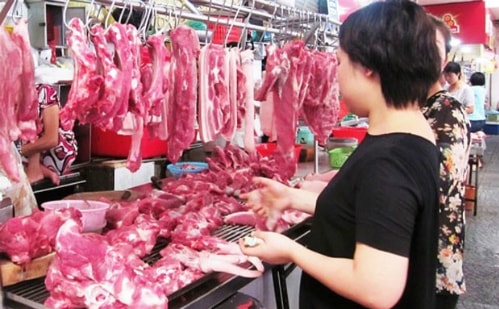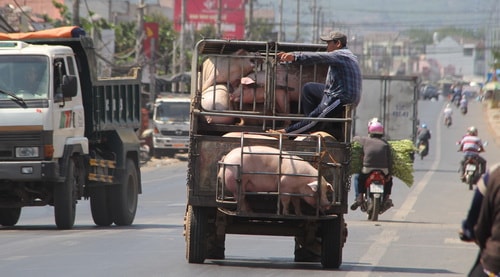Why does pork price increase 5 times when it reaches consumers?
Many types of increased costs are the main reasons given by purchasing units and traders to explain the purchase of live pigs at 23,000-25,000 VND per kg, but selling them at 160,000 VND.
Since the beginning of the year, pig farmers from Dong Nai to the northern provinces have been "crying" because the price of live pigs sold at farms and pens has dropped to a record low, only about 23,000-25,000 VND per kg, down nearly 50% compared to before, causing heavy losses for farmers.
Mr. Le Huu Thanh (residing in Quang Trung commune, Thong Nhat district) said that it takes more than 3 months to raise a pig to 100kg, while the cost of buying breeds, food, veterinary medicine... costs over 3 million VND. With the current price, for every pig sold, he loses 1-1.5 million VND. "I thought that the price of pigs would decrease for a short time and then increase again, but so far there seems to be no change, causing the farm's losses to increase. It is worth mentioning that we sell at a cheap price but have to buy pork at the market at a high price," Mr. Thanh confided.
 |
Pork prices have dropped sharply but retail prices remain unchanged. Photo: Thi Ha |
Also upset, Mr. Trinh, a farmer in Thong Nhat district (Dong Nai) said that farmers are facing many difficulties when the purchasing and distribution process is not transparent. Because companies often require purchasing quality pigs with a rate of 75% lean meat. If we assume that the farmers' pigs only meet 60% lean meat per pig (about 100kg), with a price of 27,000 VND per kg, the buyer only spends about 1.62 million VND to use this 60% lean meat. Meanwhile, the selling price at the market is many times higher due to the high transportation cost.
A survey at markets and food stores in Ho Chi Minh City shows that pork prices are still sky-high.
At the market, pork belly is 100,000 VND per kg, baby ribs 130,000 VND, rump 90,000 VND... Meanwhile, at food stores, typically Vissan, pork prices are 10,000-30,000 VND per kg higher than the market. Specifically, pork belly is up to 120,000 VND per kg, baby ribs 160,000 VND. Thus, the price of pork from farms to consumers has increased 4-5 times.
When asked about the reason why the price of live pigs has decreased but the price of meat in the market is still sky-high, Ms. Hanh, a trader at An Binh market (District 5) said that all kinds of costs from transportation to gasoline, labor have increased... so pork prices can only increase, rarely decrease. On the other hand, when taken from slaughterhouses, the price of meat has only decreased by 3,000-5,000 VND per kg, so it is difficult to adjust down.
Meanwhile, Vissan's representative explained that because the company's pork is of good quality and clean, the price is often higher than the market price. In addition, the company occasionally carries out many promotional programs to reduce prices for consumers. On the other hand, the type of pigs that the company slaughters usually meet the 100kg standard, not the over-aged type of 120kg as in the market.
Previously, Ms. Nguyen Hong Tham, Director of An Ha Service Company Limited, also explained that because the company buys from farmers, the company's purchase price is still at 37,000-39,000 VND per kilogram of live pigs, so the selling price on the market cannot decrease further. On the other hand, according to her, if the price of live pigs decreases by two, the finished pork product will only decrease by one, because 100 kg of live pigs will only produce 60-70 kg of finished meat.
 |
The management agency denied that transportation costs caused the high price of pork in the market. Photo: Phuoc Tuan |
Is a unit that purchases pigs directly from farmers and slaughters and distributes pork to markets.,Mr. Nguyen Quang Tho, Director of Thy Tho Company, said that the price of pigs purchased at the farm is 23,000-25,000 VND per kg for fat pigs, and standard pigs are 29,000 VND per kg. The cost of transporting a truckload of about 10 pigs over a distance of 20-30km costs 400,000 VND per trip; the cost of slaughtering is 60,000 VND per pig. The weight of purchased pigs is from 90 to 100 kg per pig. Thus, each kg of finished pork is 10,000-15,000 VND higher than pigs at the farm. Currently, his company wholesales pork to markets at 40,000-43,000 VND per kg. Therefore, he believes that the price of pork being pushed up twice as high is unreasonable.
“The difference between the selling price at the farm and the price to consumers seems to be flowing into the pockets of intermediaries, especially retailers and traders,” said Mr. Tho.
Not believing that the profit difference only goes into the pockets of traders, Mr. Nguyen Van Quang - Head of the Dong Nai Veterinary Department said that there are 3 groups that are benefiting. Specifically, traders, slaughterhouses and retail groups.
“Most businesses aim for profit, so once prices have increased, it is difficult to reduce them. Meanwhile, the State's control is not strict, so this is a loophole for businesses to make a profit,” Mr. Quang said, adding that it is incorrect for business groups to blame transportation costs and quarantine fees. Because the Veterinary Law has stipulated that consumption within the province is no longer subject to quarantine, and businesses almost do not have to pay veterinary fees. If in the past, veterinary fees contributed to paying staff salaries, now veterinary facilities have to ask for subsidies from the State, so businesses have reduced a lot of the burden.
On the other hand, Mr. Quang believes that the imbalance between supply and demand and the uncontrolled business environment are the reasons why farmers are currently facing losses. Therefore, according to him, the State needs to re-plan livestock farming among the people, open the market to create output for products instead of waiting for the Chinese market. If the current situation of rampant and unoriented livestock farming continues, farmers and consumers will continue to suffer.
Assessing the above situation, an industry expert in Ho Chi Minh City said that the reason why pig prices at farms are low, while retail prices are high, is because traders do not want to reduce their current profits and they abuse the transportation stage to maintain prices. Meanwhile, the management and control from farms to slaughterhouses and consumption sites are uncontrolled, "everyone does their own thing" leading to chaos in the market.
Therefore, in the coming time, to overcome this, according to this person, we should change the management in livestock farming. We need to have measures to create stability in supply and demand, actively improve breeds. Prevent the situation of pig farming and rampant pig production. In the consumption stage, we need to reduce intermediaries, control slaughtering, hygiene at the place of sale... If any unit violates, the business license will be revoked.
Recent,Minister of Agriculture and Rural Development - Nguyen Xuan Cuong has just submitted a document to the Prime Minister on groups of solutions to support the livestock industry, especially pig farming. After a period of rapid development, this industry has revealed a number of shortcomings and market inadequacies, causing the price of live pigs to drop below 30,000 VND per kg, with no signs of stopping and causing great losses to the people. To gradually stabilize the above situation, the Minister proposed that the Prime Minister direct the banking sector and credit institutions to have solutions to postpone and reduce debts for livestock farmers, animal feed and veterinary medicine traders. In addition, industry leaders also requested units with the capacity to store, process and consume a lot of meat such as businesses and the military to increase the purchase of frozen slaughtered products for pork and poultry in the coming time. |
According to VNE
| RELATED NEWS |
|---|
